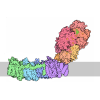+ Open data
Open data
- Basic information
Basic information
| Entry | Database: PDB / ID: 6zvh | ||||||||||||
|---|---|---|---|---|---|---|---|---|---|---|---|---|---|
| Title | EDF1-ribosome complex | ||||||||||||
 Components Components |
| ||||||||||||
 Keywords Keywords | RIBOSOME / translation / frameshifting / collision | ||||||||||||
| Function / homology |  Function and homology information Function and homology informationendothelial cell differentiation / : / negative regulation of endoplasmic reticulum unfolded protein response / oxidized pyrimidine DNA binding / response to TNF agonist / positive regulation of base-excision repair / protein tyrosine kinase inhibitor activity / positive regulation of respiratory burst involved in inflammatory response / positive regulation of intrinsic apoptotic signaling pathway in response to DNA damage / positive regulation of gastrulation ...endothelial cell differentiation / : / negative regulation of endoplasmic reticulum unfolded protein response / oxidized pyrimidine DNA binding / response to TNF agonist / positive regulation of base-excision repair / protein tyrosine kinase inhibitor activity / positive regulation of respiratory burst involved in inflammatory response / positive regulation of intrinsic apoptotic signaling pathway in response to DNA damage / positive regulation of gastrulation / nucleolus organization / regulation of adenylate cyclase-activating G protein-coupled receptor signaling pathway / IRE1-RACK1-PP2A complex / positive regulation of endodeoxyribonuclease activity / positive regulation of Golgi to plasma membrane protein transport / TNFR1-mediated ceramide production / negative regulation of RNA splicing / negative regulation of DNA repair / transcription regulator inhibitor activity / negative regulation of intrinsic apoptotic signaling pathway in response to hydrogen peroxide / supercoiled DNA binding / oxidized purine DNA binding / neural crest cell differentiation / NF-kappaB complex / ubiquitin-like protein conjugating enzyme binding / regulation of establishment of cell polarity / positive regulation of ubiquitin-protein transferase activity / negative regulation of phagocytosis / rRNA modification in the nucleus and cytosol / erythrocyte homeostasis / Formation of the ternary complex, and subsequently, the 43S complex / cytoplasmic side of rough endoplasmic reticulum membrane / laminin receptor activity / pigmentation / protein kinase A binding / negative regulation of ubiquitin protein ligase activity / Ribosomal scanning and start codon recognition / ion channel inhibitor activity / Translation initiation complex formation / positive regulation of DNA binding / positive regulation of transcription by RNA polymerase I / mammalian oogenesis stage / fibroblast growth factor binding / positive regulation of mitochondrial depolarization / activation-induced cell death of T cells / positive regulation of T cell receptor signaling pathway / negative regulation of peptidyl-serine phosphorylation / iron-sulfur cluster binding / negative regulation of Wnt signaling pathway / positive regulation of activated T cell proliferation / monocyte chemotaxis / Protein hydroxylation / regulation of cell division / BH3 domain binding / cysteine-type endopeptidase activator activity involved in apoptotic process / mTORC1-mediated signalling / SARS-CoV-1 modulates host translation machinery / Peptide chain elongation / positive regulation of intrinsic apoptotic signaling pathway by p53 class mediator / TFIID-class transcription factor complex binding / Selenocysteine synthesis / positive regulation of signal transduction by p53 class mediator / Formation of a pool of free 40S subunits / ubiquitin ligase inhibitor activity / Eukaryotic Translation Termination / phagocytic cup / regulation of lipid metabolic process / negative regulation of respiratory burst involved in inflammatory response / Response of EIF2AK4 (GCN2) to amino acid deficiency / SRP-dependent cotranslational protein targeting to membrane / Viral mRNA Translation / negative regulation of phosphatidylinositol 3-kinase/protein kinase B signal transduction / Nonsense Mediated Decay (NMD) independent of the Exon Junction Complex (EJC) / photoreceptor outer segment / GTP hydrolysis and joining of the 60S ribosomal subunit / L13a-mediated translational silencing of Ceruloplasmin expression / TOR signaling / endonucleolytic cleavage to generate mature 3'-end of SSU-rRNA from (SSU-rRNA, 5.8S rRNA, LSU-rRNA) / T cell proliferation involved in immune response / regulation of translational fidelity / spindle assembly / positive regulation of cell cycle / Major pathway of rRNA processing in the nucleolus and cytosol / erythrocyte development / Nonsense Mediated Decay (NMD) enhanced by the Exon Junction Complex (EJC) / negative regulation of ubiquitin-dependent protein catabolic process / Amplification of signal from unattached kinetochores via a MAD2 inhibitory signal / Protein methylation / positive regulation of intrinsic apoptotic signaling pathway / ribosomal small subunit export from nucleus / Nuclear events stimulated by ALK signaling in cancer / translation regulator activity / signaling adaptor activity / positive regulation of phagocytosis / laminin binding / negative regulation of smoothened signaling pathway / stress granule assembly / Mitotic Prometaphase / rough endoplasmic reticulum / endonucleolytic cleavage in ITS1 to separate SSU-rRNA from 5.8S rRNA and LSU-rRNA from tricistronic rRNA transcript (SSU-rRNA, 5.8S rRNA, LSU-rRNA) Similarity search - Function | ||||||||||||
| Biological species |  Homo sapiens (human) Homo sapiens (human) | ||||||||||||
| Method | ELECTRON MICROSCOPY / single particle reconstruction / cryo EM / Resolution: 2.9 Å | ||||||||||||
 Authors Authors | Best, K.M. / Denk, T. / Cheng, J. / Thoms, M. / Berninghausen, O. / Beckmann, R. | ||||||||||||
| Funding support |  Germany, Germany,  United States, 3items United States, 3items
| ||||||||||||
 Citation Citation |  Journal: Elife / Year: 2020 Journal: Elife / Year: 2020Title: EDF1 coordinates cellular responses to ribosome collisions. Authors: Niladri K Sinha / Alban Ordureau / Katharina Best / James A Saba / Boris Zinshteyn / Elayanambi Sundaramoorthy / Amit Fulzele / Danielle M Garshott / Timo Denk / Matthias Thoms / Joao A ...Authors: Niladri K Sinha / Alban Ordureau / Katharina Best / James A Saba / Boris Zinshteyn / Elayanambi Sundaramoorthy / Amit Fulzele / Danielle M Garshott / Timo Denk / Matthias Thoms / Joao A Paulo / J Wade Harper / Eric J Bennett / Roland Beckmann / Rachel Green /   Abstract: Translation of aberrant mRNAs induces ribosomal collisions, thereby triggering pathways for mRNA and nascent peptide degradation and ribosomal rescue. Here we use sucrose gradient fractionation ...Translation of aberrant mRNAs induces ribosomal collisions, thereby triggering pathways for mRNA and nascent peptide degradation and ribosomal rescue. Here we use sucrose gradient fractionation combined with quantitative proteomics to systematically identify proteins associated with collided ribosomes. This approach identified Endothelial differentiation-related factor 1 (EDF1) as a novel protein recruited to collided ribosomes during translational distress. Cryo-electron microscopic analyses of EDF1 and its yeast homolog Mbf1 revealed a conserved 40S ribosomal subunit binding site at the mRNA entry channel near the collision interface. EDF1 recruits the translational repressors GIGYF2 and EIF4E2 to collided ribosomes to initiate a negative-feedback loop that prevents new ribosomes from translating defective mRNAs. Further, EDF1 regulates an immediate-early transcriptional response to ribosomal collisions. Our results uncover mechanisms through which EDF1 coordinates multiple responses of the ribosome-mediated quality control pathway and provide novel insights into the intersection of ribosome-mediated quality control with global transcriptional regulation. | ||||||||||||
| History |
|
- Structure visualization
Structure visualization
| Movie |
 Movie viewer Movie viewer |
|---|---|
| Structure viewer | Molecule:  Molmil Molmil Jmol/JSmol Jmol/JSmol |
- Downloads & links
Downloads & links
- Download
Download
| PDBx/mmCIF format |  6zvh.cif.gz 6zvh.cif.gz | 1.8 MB | Display |  PDBx/mmCIF format PDBx/mmCIF format |
|---|---|---|---|---|
| PDB format |  pdb6zvh.ent.gz pdb6zvh.ent.gz | 1.3 MB | Display |  PDB format PDB format |
| PDBx/mmJSON format |  6zvh.json.gz 6zvh.json.gz | Tree view |  PDBx/mmJSON format PDBx/mmJSON format | |
| Others |  Other downloads Other downloads |
-Validation report
| Summary document |  6zvh_validation.pdf.gz 6zvh_validation.pdf.gz | 1.5 MB | Display |  wwPDB validaton report wwPDB validaton report |
|---|---|---|---|---|
| Full document |  6zvh_full_validation.pdf.gz 6zvh_full_validation.pdf.gz | 1.6 MB | Display | |
| Data in XML |  6zvh_validation.xml.gz 6zvh_validation.xml.gz | 157.1 KB | Display | |
| Data in CIF |  6zvh_validation.cif.gz 6zvh_validation.cif.gz | 265.7 KB | Display | |
| Arichive directory |  https://data.pdbj.org/pub/pdb/validation_reports/zv/6zvh https://data.pdbj.org/pub/pdb/validation_reports/zv/6zvh ftp://data.pdbj.org/pub/pdb/validation_reports/zv/6zvh ftp://data.pdbj.org/pub/pdb/validation_reports/zv/6zvh | HTTPS FTP |
-Related structure data
| Related structure data |  11456MC  6zviC M: map data used to model this data C: citing same article ( |
|---|---|
| Similar structure data |
- Links
Links
- Assembly
Assembly
| Deposited unit | 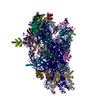
|
|---|---|
| 1 |
|
- Components
Components
-RNA chain , 2 types, 2 molecules 2x
| #1: RNA chain | Mass: 561308.438 Da / Num. of mol.: 1 / Source method: isolated from a natural source / Source: (natural)  Homo sapiens (human) Homo sapiens (human) |
|---|---|
| #35: RNA chain | Mass: 24004.262 Da / Num. of mol.: 1 / Source method: isolated from a natural source / Source: (natural)  Homo sapiens (human) Homo sapiens (human) |
+40S ribosomal protein ... , 31 types, 31 molecules ABDEFHIKLPQRSTUVXacdCGJMNOWYZbe
-Protein , 4 types, 4 molecules gfyi
| #22: Protein | Mass: 34669.113 Da / Num. of mol.: 1 / Source method: isolated from a natural source / Source: (natural)  Homo sapiens (human) / References: UniProt: P63244 Homo sapiens (human) / References: UniProt: P63244 |
|---|---|
| #34: Protein | Mass: 7884.286 Da / Num. of mol.: 1 / Source method: isolated from a natural source / Source: (natural)  Homo sapiens (human) / References: UniProt: P62979 Homo sapiens (human) / References: UniProt: P62979 |
| #36: Protein | Mass: 8557.207 Da / Num. of mol.: 1 / Source method: isolated from a natural source / Source: (natural)  Homo sapiens (human) / References: UniProt: Q9NX58 Homo sapiens (human) / References: UniProt: Q9NX58 |
| #37: Protein | Mass: 12330.996 Da / Num. of mol.: 1 / Source method: isolated from a natural source / Source: (natural)  Homo sapiens (human) / References: UniProt: O60869 Homo sapiens (human) / References: UniProt: O60869 |
-Non-polymers , 2 types, 33 molecules 


| #38: Chemical | ChemComp-MG / #39: Chemical | |
|---|
-Details
| Has ligand of interest | N |
|---|
-Experimental details
-Experiment
| Experiment | Method: ELECTRON MICROSCOPY |
|---|---|
| EM experiment | Aggregation state: PARTICLE / 3D reconstruction method: single particle reconstruction |
- Sample preparation
Sample preparation
| Component | Name: EDF1-ribosome complex / Type: RIBOSOME / Entity ID: #1-#37 / Source: NATURAL |
|---|---|
| Source (natural) | Organism:  Homo sapiens (human) Homo sapiens (human) |
| Buffer solution | pH: 7.5 |
| Specimen | Embedding applied: NO / Shadowing applied: NO / Staining applied: NO / Vitrification applied: YES |
| Vitrification | Cryogen name: ETHANE |
- Electron microscopy imaging
Electron microscopy imaging
| Experimental equipment |  Model: Titan Krios / Image courtesy: FEI Company |
|---|---|
| Microscopy | Model: FEI TITAN KRIOS |
| Electron gun | Electron source:  FIELD EMISSION GUN / Accelerating voltage: 300 kV / Illumination mode: OTHER FIELD EMISSION GUN / Accelerating voltage: 300 kV / Illumination mode: OTHER |
| Electron lens | Mode: BRIGHT FIELD |
| Image recording | Electron dose: 28 e/Å2 / Film or detector model: GATAN K2 SUMMIT (4k x 4k) |
- Processing
Processing
| Software |
| ||||||||||||||||||||||||
|---|---|---|---|---|---|---|---|---|---|---|---|---|---|---|---|---|---|---|---|---|---|---|---|---|---|
| CTF correction | Type: PHASE FLIPPING AND AMPLITUDE CORRECTION | ||||||||||||||||||||||||
| 3D reconstruction | Resolution: 2.9 Å / Resolution method: FSC 0.143 CUT-OFF / Num. of particles: 81976 / Symmetry type: POINT | ||||||||||||||||||||||||
| Refinement | Cross valid method: NONE Stereochemistry target values: GeoStd + Monomer Library + CDL v1.2 | ||||||||||||||||||||||||
| Displacement parameters | Biso mean: 55.5 Å2 | ||||||||||||||||||||||||
| Refine LS restraints |
|
 Movie
Movie Controller
Controller





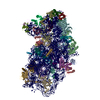


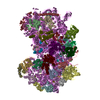
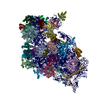
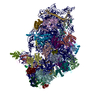
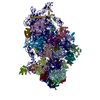

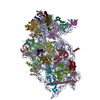
 PDBj
PDBj





































